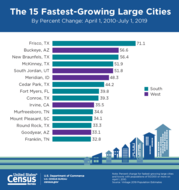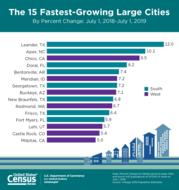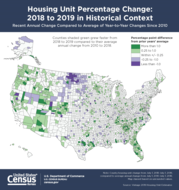Southern and Western Regions Experienced Rapid Growth This Decade

Ten of the Fifteen Fastest-Growing Cities and Towns in the South
MAY 21, 2020 — Since 2010, populations in cities in the southern and western regions of the United States experienced rapid growth. The South leads the way with 10 of the top 15 fastest-growing large U.S. cities, with a population of 50,000 or more, according to new population estimates for cities and towns, the Census Bureau reports today.
“Frisco, Texas, tops the list of the fastest-growing large cities with a growth rate of 71.1%, increasing its population by more than half since April 1, 2010,” says Amel Toukabri, chief of the Local Government Estimates and Migration Processing Branch in the Census Bureau’s Population Division. For a complete list, see fastest-growing large cities 2010-2019.
With respect to numeric change, cities in Texas are among those that have added the most people this decade. Collectively, Houston, San Antonio, Austin, Fort Worth and Dallas increased by almost 933,600 people. This equals 39.5% of the roughly 2.4 million increase by the top 15 numeric gainers.
Among the 15 U.S. cities or towns with populations of 50,000 or more as of April 1, 2010, that had the largest numeric increases since 2010, eight were located in the South, five in the West, and one each in the Northeast and the Midwest. Phoenix, Ariz., tops the list of the 15 largest numeric gainers with an increase of over 234,300 people or an average of 25,330 people per year between 2010 and 2019. Aside from New York, New York, and Columbus, Ohio, the other cities making up the list of the largest numeric gainers were located in the South or West.
|
Most Populous Cities Since 2010
Nine years after the 2010 Census, New York continued to be the nation's most populous city by a wide margin, with 8.3 million residents on July 1, 2019, followed by Los Angeles (almost 4 million) and Chicago (about 2.7 million). The composition of the list of the 15 most populous cities has remained largely unchanged; nevertheless, two new cities (Fort Worth, in 13th place, and Charlotte, N.C., in 15th place) joined as of July 1, 2019, and Indianapolis, Ind., and San Francisco, Calif., both fell out of the top 15 and the list's order has changed slightly.
Population Milestones Since 2010
- Four areas surpassed the 500,000 mark between 2010 and 2019, including three in the West and one in the South. Cities in the West were Mesa, Ariz. (518,012); Fresno, Calif. (531,576); and Sacramento, Calif. (513,624). Atlanta, Ga., grew by 18.7% to a population of about 506,800, the only area that exceeded the threshold in the South.
- San Jose, Calif., is the only city to cross the population threshold of one million since 2010.
America’s Composition of Big Cities and Small Towns Unchanged Since 2010
The United States’ composition remains a mix of big cities and small towns. While only 4.0% (780) of all cities had a population of 50,000 or more in 2019, collectively they contained 127.7 million people out of the nation’s 328.2 million — nearly 61% of the U.S. population living in incorporated places. On the other hand, of the 19,502 cities and towns in the United States, around 76% (14,754) had fewer than 5,000 people as of July 1, 2019.
Regional Average Growth and Decline Since 2010
Overall, large cities in the South with populations of 50,000 or more continue to grow at a faster pace than in any other U.S region. Since the 2010 Census, the populations of large southern cities increased by an average of 11.8%. In contrast, large cities in the West grew by 9.1%, whereas large cities in the Northeast and Midwest grew by 1.5% and 3.1%, respectively.
On average, small cities and towns — those with fewer than 5,000 people — have seen uneven growth across U.S. regions:
- Western small towns saw the largest growth with an increase of 13.3%.
- Southern small towns grew by 6.7%.
- Northeastern small towns declined by 3.0%.
- Midwest small towns declined by 1.7%.
Mid-sized cities in the Northeast, places with populations between 5,000 and 9,999, experienced relative stability, seeing a small average decline of 0.9% since the 2010 Census. Mid-sized cities in the other regions experienced population growth, on average.

Other Highlights
Population Gain: July 1, 2018, to July 1, 2019
Between 2018 and 2019, Leander, Texas, was the fastest-growing large city, increasing by 12%, making its growth rate 24 times faster than the nation’s growth rate of 0.5%. See infographic: fastest-growing large cities 2018-2019.
Over the same period, the South had seven big cities among the top 15 with the largest numeric population change. This is consistent with the period from 2010 to 2019. Likewise, Phoenix, Ariz., once again tops this list for both periods to mark the largest numeric gain: an average increase of 72 people per day between July 1, 2018, and July 1, 2019. Rounding out the top five with the largest population increases were San Antonio, Texas (17,237); Austin, Texas (16,439); Fort Worth, Texas (16,369); and Charlotte, N.C. (13,194).
Some other cities in the South with the largest population gains were Frisco, Texas (12,038); Jacksonville, Fla. (9,070); and Atlanta, Ga. (8,628), which crossed the 500,000 threshold as of July 1, 2019. In the West, the other cities experiencing large population increases were Seattle, Wash. (11,440); Denver, Colo. (10,946); Henderson, Nev. (10,671); Mesa, Ariz. (10,067); Chico, Calif. (8,959); Las Vegas, Nev. (8,091); and Meridian, Idaho (7,697).
For more specific information on the top 15 cities and towns, with a population of 10,000 or more, by percent change and their ranking within each state, check out the cities and towns data visualization.
Six cities and towns crossed the 100,000 population mark in 2019. These were Chico, Calif. (103,301); Vacaville, Calif. (100,670); Carmel, Ind. (101,068); Bend, Ore. (100,421); Edinburg, Texas (101,170); and Spokane Valley, Wash., (101,060).
Additionally, nine areas surpassed 50,000 in population in 2019: four areas in the West, three areas in the South, and two areas in the Midwest. These were Queen Creek, Ariz. (50,890); Beaumont, Calif. (51,063); Twin Falls, Idaho (50,197); Mishawaka, Ind. (50,363); West Lafayette, Ind. (50,996); Kannapolis, N.C. (50,841); Little Elm, Texas (53,126); Texas City, Texas (50,094); and Herriman, Utah (51,348).
|

Housing Unit Growth Remained Steady in Nearly All States
The nation’s housing stock grew by about 1.2 million housing units between 2018 and 2019, reaching a total of 139.7 million. The annual growth rate of 0.8% from 2018 to 2019 remained the same as the prior year.
Five states gained more than 50,000 housing units between 2018 and 2019: Texas (185,000), Florida (128,000), California (91,000), North Carolina (64,000) and Georgia (53,000).
Utah was the fastest-growing state in terms of housing units, with an increase of 2.2% between 2018 and 2019. Idaho was the second-fastest-growing state, at a 2.1% growth rate, followed by Colorado and Texas with increases of 1.7%.
Housing Unit Change Since Census Day (April 1, 2010)
The nation’s housing stock grew by 8 million units (about 6.1%) since April 1, 2010. North Dakota was the fastest-growing state in terms of housing units, with an increase of 19.7% during the same period. Rounding out the top five gainers were Utah (15.7%), Texas (13.1%), Idaho (12.5%) and Colorado (11.4%).
Fourteen states added more than 150,000 housing units between April 1, 2010, and July 1, 2019. The top six with the largest numeric increases were Texas (1.3 million), California (686,000), Florida (684,000), North Carolina (420,000), Washington (309,000) and New York (296,000).
When compared to the previous years’ average growth, the county housing unit growth rate has substantially slowed down in most counties and accelerated in the fastest-growing large cities in the South. A map is available with additional data for housing unit change by county. It displays the county housing unit percentage change from 2018 to 2019 compared to the average year-to-year change for the same county between 2010 and 2018. Counties shaded green grew faster from 2018 to 2019 compared to their average annual change from 2010 to 2018.
|
The statistics released today cover all local functioning governmental units, including incorporated places (like cities and towns), minor civil divisions (such as townships), and consolidated cities (government units for which the functions of an incorporated place and its parent county have merged).
On June 25, 2020, the Census Bureau will release estimates of the July 1, 2019, population for the nation, states and counties by age, sex, race and Hispanic origin. Population estimates for Puerto Rico and its municipios by age and sex will be released as well. These estimates include counties and cities affected by the 2018 hurricane season. The data will be embargoed (June 23, 2020).
American FactFinder (AFF) was retired on March 31, 2020, and has been replaced by data.census.gov. Population and housing unit estimates data previously released on AFF are now available on the Population and Housing Unit Estimates website. With each new release of annual estimates, the entire time series of estimates is revised for all years back to the last census. All previously published estimates (e.g., old vintages) are superseded and archived on the FTP2 site. Files previously released on AFF are also available on the FTP2 site. Please use the searchable index of the FTP2 site for a complete inventory of all content available on the site.
The Census Bureau develops city and town population estimates by measuring population change since the most recent census. The Census Bureau uses administrative records on births, deaths and migration to develop estimates of population. For more detail regarding the methodology, see <www.census.gov/programs-surveys/popest/technical-documentation/methodology.html>.
###
Press Kit
Graphic 1 | JPG | PDF |
Graphic 2 | JPG | PDF |
Graphic 3 | JPG | PDF |
|